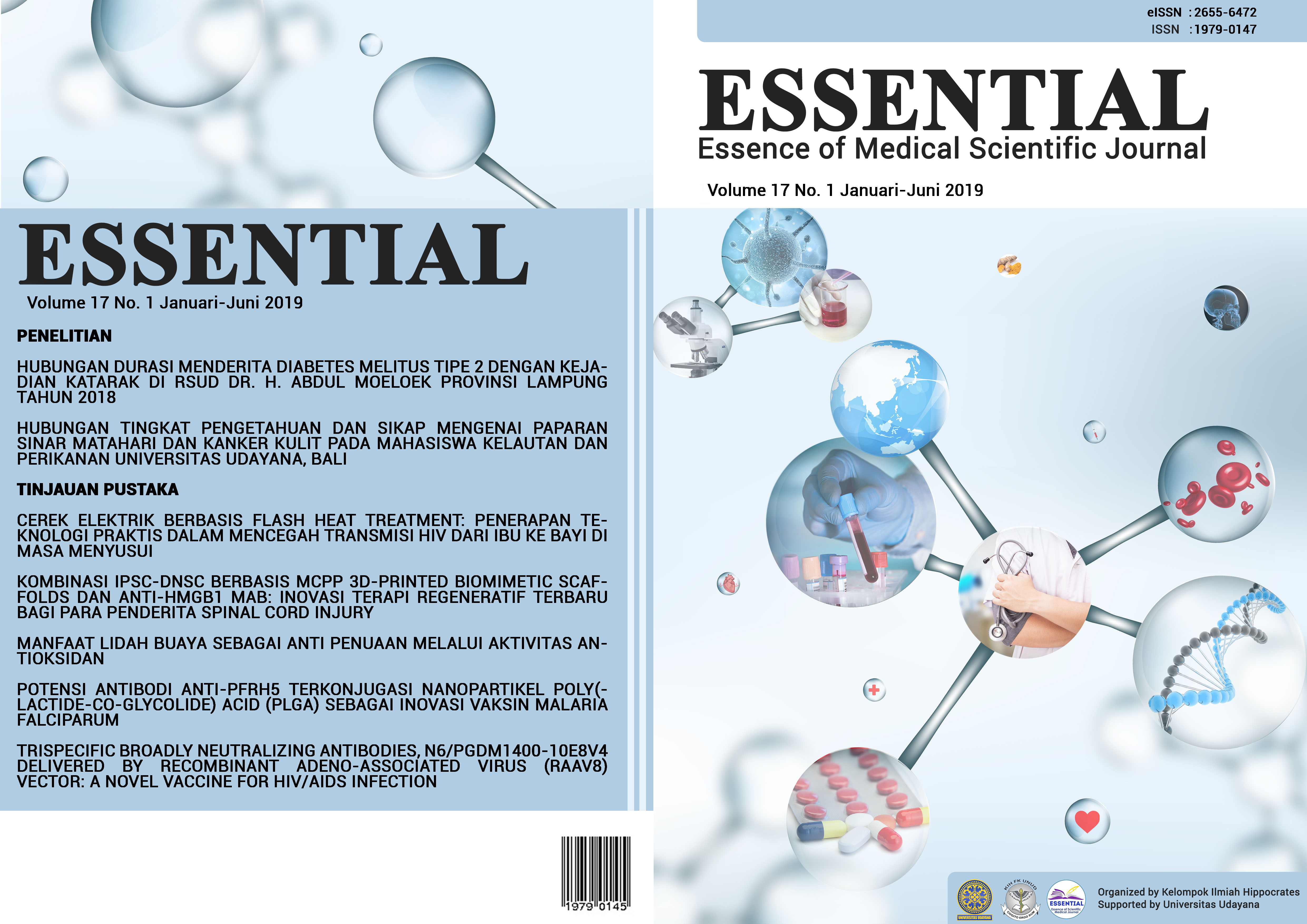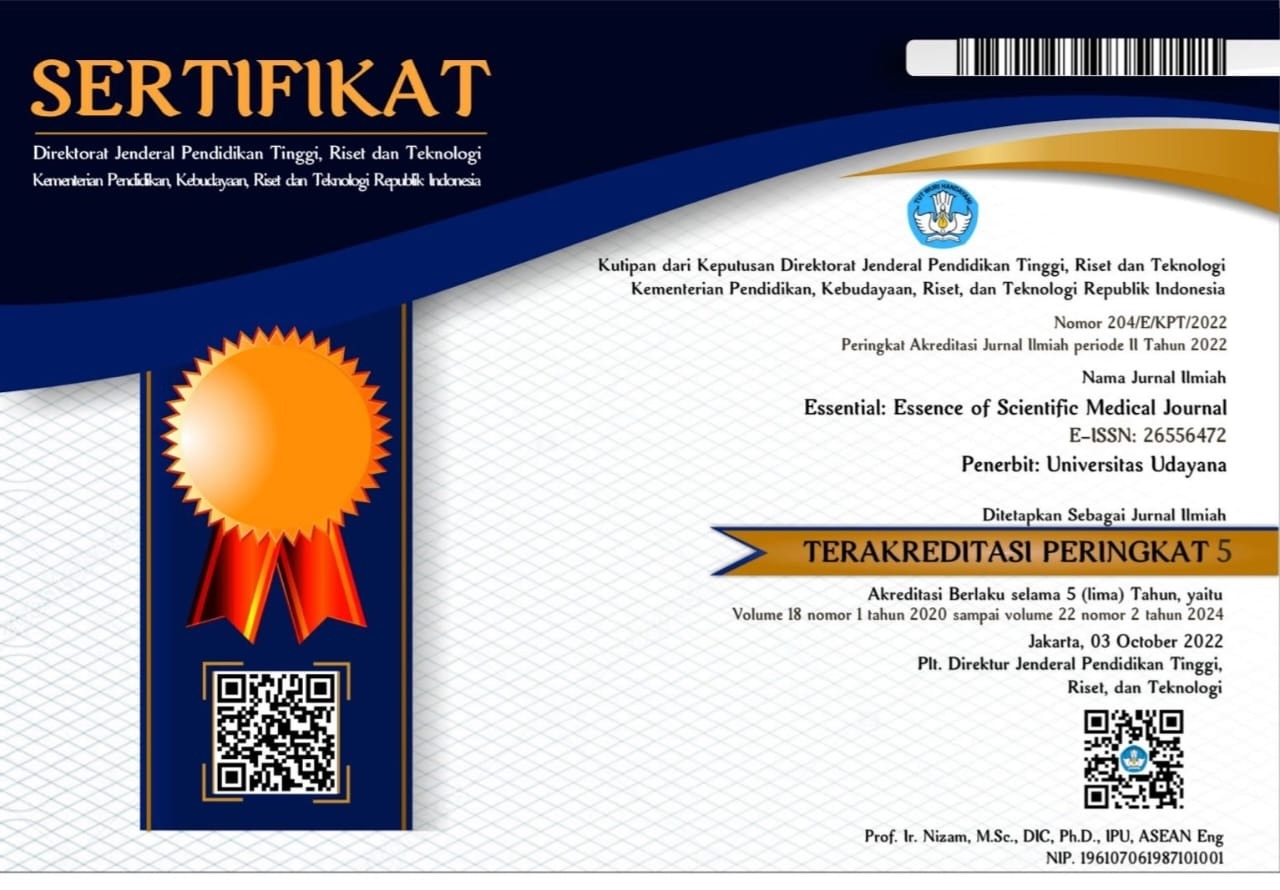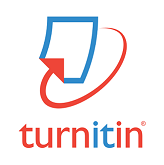KOMBINASI IPSC-DNSC BERBASIS ?CPP 3D-PRINTED BIOMIMETIC SCAFFOLDS DAN ANTI-HMGB1 MAB: INOVASI TERAPI REGENERATIF TERBARU BAGI PARA PENDERITA SPINAL CORD INJURY
Abstract
ABSTRAK
Pendahuluan: Spinal cord injury (SCI) atau cedera tulang belakang merupakan sebuah kondisi patologis yang disebabkan akibat terjadinya kerusakan pada medula spinalis. Kondisi ini telah menjadi salah satu permasalahan kesehatan global yang paling kompleks karena tidak hanya menyebabkan kelainan neurologis, tetapi juga menimbulkan beban psikis dan sosial yang berat bagi para penderitanya. Baru-baru ini, sebuah terapi berbasis sel punca telah berhasil dikembangkan dan dapat menjadi solusi bagi permasalahan kesehatan yang satu ini. Sebuah sel punca berjenis iPSC-dNSC telah terbukti tidak hanya efektif dalam menginisiasi regenerasi sel neuron pada lokasi lesi SCI, tetapi juga dapat meredakan kondisi inflamasi yang terjadi pasca-trauma. Selanjutnya, untuk dapat menjaga kestabilan dan efek regeneratif dari iPSC-dNSCs, peneliti kemudian menggunakan sebuah media yang bernama ?CPP 3D-printed biomimetic scaffolds untuk menjadi wadah bagi sel punca tersebut. Sedangkan, untuk dapat meningkatkan efektifitas dari iPSC-dNSCs agar lebih poten lagi, peneliti mengkombinasikan terapi ini dengan sebuah terapi neuroprotektif terbaru bernama anti-HMGB1 mAb.
Pembahasan: Studi literatur ini menunjukan bahwa terapi kombinasi iPSC-dNSC berbasis ?CPP 3D-printed biomimetic scaffolds dan anti-HMGB1 mAb telah terbukti mampu mengembalikan fungsi lokomotor hingga mendekati normal kembali, dengan didapatkannya nilai skor ~7 pada pemeriksaan dengan teknik skoring Basso Mouse Scale (BMS).
Simpulan: Dengan demikian, dapat disimpulkan bahwa terapi kombinasi iPSC-dNSC berbasis ?CPP 3D-printed biomimetic scaffolds dengan anti-HMGB1 mAb memiliki potensi yang menjanjikan untuk menjadi terapi utama bagi para penderita SCI diseluruh dunia
Kata Kunci: Anti-HMGB1 mAb, iPSC-dNSC, NSC, SCI, ?CPP
Downloads
References
1. Stucki G, Bickenbach J. The International Spinal Cord Injury Survey and the Learning Health System for Spinal Cord Injury. American journal of physical medicine & rehabilitation. 2017 Feb 1;96(2):S2-4.
2. Kang Y, Ding H, Zhou H, Wei Z, Liu L, Pan D, Feng S. Epidemiology of worldwide spinal cord injury: a literature review. Journal of Neurorestoratology. 2017 Dec 29;6:1-9.
3. Raspa A, Pugliese R, Maleki M, Gelain F. Recent therapeutic approaches for spinal cord injury. Biotechnology and bioengineering. 2016 Feb;113(2):253-9.
4. Silver J, Schwab ME, Popovich PG. Central nervous system regenerative failure: role of oligodendrocytes, astrocytes, and microglia. Cold Spring Harbor perspectives in biology. 2015 Mar 1;7(3):a020602.
5. Ahuja CS, Fehlings M. Concise review: bridging the gap: novel neuroregenerative and neuroprotective strategies in spinal cord injury. Stem cells translational medicine. 2016 Jul 1;5(7):914-24.
6. Hodgetts SI, Harvey AR. Neurotrophic factors used to treat spinal cord injury. InVitamins and hormones. Academic Press. 2017;104:405-57.
7. Wilems TS, Pardieck J, Iyer N, Sakiyama-Elbert SE. Combination therapy of stem cell derived neural progenitors and drug delivery of anti-inhibitory molecules for spinal cord injury. Acta biomaterialia. 2015 Dec 31;28:23-32.
8. Wilems TS, Sakiyama-Elbert SE. Sustained dual drug delivery of anti-inhibitory molecules for treatment of spinal cord injury. Journal of Controlled Release. 2015 Sep 10;213:103-11.
9. Assinck P, Duncan GJ, Hilton BJ, Plemel JR, Tetzlaff W. Cell transplantation therapy for spinal cord injury. Nature neuroscience. 2017 May;20(5):637.
10. Yousefifard M, Rahimi-Movaghar V, Nasirinezhad F, Baikpour M, Safari S, Saadat S, Jafari AM, Asady H, Tousi SR, Hosseini M. Neural stem/progenitor cell transplantation for spinal cord injury treatment; A systematic review and meta-analysis. Neuroscience. 2016 May 13;322:377-97.
11. Stenudd M, Sabelström H, Frisén J. Role of endogenous neural stem cells in spinal cord injury and repair. JAMA neurology. 2015 Feb 1;72(2):235-7.
12. Lee-Kubli CA, Lu P. Induced pluripotent stem cell-derived neural stem cell therapies for spinal cord injury. Neural regeneration research. 2015 Jan;10(1):10.
13. Khazaei M, Ahuja CS, Rodgers CE, Chan P, Fehlings MG. Generation of Definitive Neural Progenitor Cells from Human Pluripotent Stem Cells for Transplantation into Spinal Cord Injury. InNeural Stem Cells. 2019:25-41.
14. Salewski RP, Mitchell RA, Li L, Shen C, Milekovskaia M, Nagy A, Fehlings MG. Transplantation of induced pluripotent stem cell‐derived neural stem cells mediate functional recovery following thoracic spinal cord injury through remyelination of axons. Stem cells translational medicine. 2015 Jul 1;4(7):743-54.
15. Curtis E, Martin JR, Gabel B, Sidhu N, Rzesiewicz TK, Mandeville R, Van Gorp S, Leerink M, Tadokoro T, Marsala S, Jamieson C. A First-in-Human, Phase I Study of Neural Stem Cell Transplantation for Chronic Spinal Cord Injury. Cell stem cell. 2018 Jun 1;22(6):941-50.
16. Romanyuk N, Amemori T, Turnovcova K, Prochazka P, Onteniente B, Sykova E, Jendelova P. Beneficial effect of human induced pluripotent stem cell-derived neural precursors in spinal cord injury repair. Cell transplantation. 2015 Sep 14;24(9):1781-97.
17. Koffler J, Zhu W, Qu X, Platoshyn O, Dulin JN, Brock J, et al. Biomimetic 3D-printed scaffolds for spinal cord injury repair. Nat Med. 2019 Feb 1;25(2):263–9.
18. Shin JE, Jung K, Kim M, Hwang K, Lee H, Kim IS, Lee BH, Lee IS, Park KI. Brain and spinal cord injury repair by implantation of human neural progenitor cells seeded onto polymer scaffolds. Experimental & molecular medicine. 2018 Apr 20;50(4):39.
19. Kang PH, Kumar S, Schaffer DV. Novel biomaterials to study neural stem cell mechanobiology and improve cell-replacement therapies. Current opinion in biomedical engineering. 2017 Dec 1;4:13-20.
20. Führmann T, Anandakumaran PN, Shoichet MS. Combinatorial therapies after spinal cord injury: how can biomaterials help?. Advanced healthcare materials. 2017 May;6(10):1601130.
21. Papatheodorou A, Stein A, Bank M, Sison CP, Gibbs K, Davies P, Bloom O. High-mobility group box 1 (HMGB1) is elevated systemically in persons with acute or chronic traumatic spinal cord injury. Journal of neurotrauma. 2017 Feb 1;34(3):746-54.
22. Kigerl KA, Lai W, Wallace LM, Yang H, Popovich PG. High mobility group box-1 (HMGB1) is increased in injured mouse spinal cord and can elicit neurotoxic inflammation. Brain, behavior, and immunity. 2018 Aug 1;72:22-33.
23. Sun L, Li M, Ma X, Feng H, Song J, Lv C, He Y. Inhibition of HMGB1 reduces rat spinal cord astrocytic swelling and AQP4 expression after oxygen-glucose deprivation and reoxygenation via TLR4 and NF-κB signaling in an IL-6-dependent manner. Journal of neuroinflammation. 2017 Dec;14(1):231.
24. Sun L, Li M, Ma X, Zhang L, Song J, Lv C, He Y. Inhibiting high mobility group box-1 reduces early spinal cord edema and attenuates astrocyte activation and aquaporin-4 expression after spinal cord injury in rats. Journal of neurotrauma. 2018 Jun 21(ja).
25. Nakajo M, Uezono N, Nakashima H, Wake H, Komiya S, Nishibori M, Nakashima K. Therapeutic time window of anti-high mobility group box-1 antibody administration in mouse model of spinal cord injury. Neuroscience research. 2018 Mar 28.
26. Uezono N, Zhu Y, Fujimoto Y, Yasui T, Matsuda T, Nakajo M, Abematsu M, Setoguchi T, Mori S, Takahashi HK, Komiya S. Prior Treatment with Anti‐High Mobility Group Box‐1 Antibody Boosts Human Neural Stem Cell Transplantation‐Mediated Functional Recovery After Spinal Cord Injury. Stem Cells. 2018 May;36(5):737-50.
27. Oh SK, Jeon SR. Current Concept of Stem Cell Therapy for Spinal Cord Injury: A Review. Korean J Neurotrauma. 2016;12(2):40-46.
28. Fischer I, Hou S. Using Neural Stem Cells to Enhance Repair and Recovery of Spinal Circuits After Injury. Oxford Research Encyclopedia of Neuroscience. 2018.
29. Zhu Y, Uezono N, Yasui T, Nakashima K. Neural stem cell therapy aiming at better functional recovery after spinal cord injury. Dev Dyn. 2018;247:75-84.
30. Rugnetta M. Neural stem cell | biology [Internet]. Encyclopedia Britannica. 2019 [cited 9 February 2019]. Available from: https://www.britannica.com/science/neural-stem-cell
31. Bond AM, Ming GL, Song H. Adult Mammalian Neural Stem Cells and Neurogenesis: Five Decades Later. Cell Stem Cell. 2015;17(4):385-95.
32. Iwai H, Nori S, Nishimura S, Yasuda A, Takano M, Tsuji O, et al. Transplantation of neural stem/progenitor cells at different locations in mice with spinal cord injury. Cell Transplant. 2014;23(11):1451-64. doi: 10.3727/096368913X670967
33. Sharp KG, Yee KM, Steward O. A re-assessment of long distance growth and connectivity of neural stem cells after severe spinal cord injury. Exp Neurol. 2014;257:186-204.
34. Cheng Z, Zhu W, Cao K, Wu F, Li J, Wang G, et al. Anti-inflammatory mechanism of neural stem cell transplantation in spinal cord injury. Int. J. Mol. Sci. 2016;17:1380.
35. Rosenzweig ES, Brock JH, Lu P, Kumamaru H, Salegio EA, Kadoya K, Weber JL, et al. Restorative effects of human neural stem cell grafts on the primate spinal cord. Nature medicine. 2018 Apr;24(4):484.
36. Xiong LL, Zou Y, Shi Y, Zhang P, Zhang RP, Dai XJ, et al. Tree shrew neural stem cell transplantation promotes functional recovery of tree shrews with a hemi‑sectioned spinal cord injury by upregulating nerve growth factor expression. International journal of molecular medicine. 2018 Jun 1;41(6):3267-77.
37. Yasuda A, Tsuji O, Shibata S, Nori S, Takano M, Kobayashi Y, et al. Significance of remyelination by neural stem/progenitor cells transplanted into the injured spinal cord. Stem Cells. 2011 Dec;29(12):1983-94.
38. Ghobrial GM, Anderson KD, Dididze M, Martinez-Barrizonte J, Sunn GH, Gant KL, et al. Human Neural Stem Cell Transplantation in Chronic Cervical Spinal Cord Injury: Functional Outcomes at 12 Months in a Phase II Clinical Trial. Neurosurgery. 2017;64:87-91.
39. Levi AD, Anderson KD, Okonkwo DO, Park P, Bryce TN, Kurpad SN. Clinical outcomes from a multi-center study of human neural stem cell transplantation in chronic cervical spinal cord injury. J Neurotrauma. 2018.
40. Lu P, Woodruff G, Wang Y, et al. Long-distance axonal growth from human induced pluripotent stem cells after spinal cord injury. Neuron. 2014;83(4):789-96.
41. Fan L, Liu C, Chen X, Zou Y, Zhou Z, Lin C, et al. Directing induced pluripotent stem cell derived neural stem cell fate with a three-dimensional biomimetic hydrogel for spinal cord injury repair. ACS Appl Mater Interfaces. 2018;10(21):17742-5.
42. Hong JY, Lee SH, Lee SC, Kim JW, Kim KP, Kim SM, et al. Therapeutic potential of induced neural stem cell for spinal cord injury. J Biol Chem. 2014;289(47):32512-25.
43. Gomes ED, Silva NA, Salgado AJ. Combinatorial therapies for spinal cord injury: strategies to induce regeneration. Neural Regen Res. 2019;14(1):69-71.
44. Shrestha B, Coykendall K, Li Y, Moon A, Priyadarshani P, Yao L. Repair of injured spinal cord using biomaterial scaffolds and stem cells. Stem Cell Res Ther. 2014;5(4):91. Published 2014 Aug 1. doi:10.1186/scrt480
45. Li X, Liu D, Xiao Z, Zhao Y, Han S, Chen B, et al. Scaffold-facilitated locomotor improvement post complete spinal cord injury: motor axon regeneration versus endogenous neuronal relay formation. 2019;197:20-31.
46. Ai J, Kiasat-Dolatabadi A, Ebrahimi-Barough S, Ai A, Lotfibakhshaiesh N, et al. Polymeric Scaffolds in Neural Tissue Engineering: A Review, Arch Neurosci. 2014 ; 1(1):15-20. doi: 10.5812/archneurosci.9144.
47. Zhang Q, Shi B, Ding J, Yan L, Thawani JP, Fu C, et al. Polymer scaffolds facilitate spinal cord injury repair. Acta Biomaterialia. 2019.
48. Zhao W, Li J, Jin K, Liu W, Qiu X, Li C. Fabrication of functional PLGA-based electrospun scaffolds and their applications in biomedical engineering. Materials Science and Engineering:C. 2016;59:1181-94.
49. Do AV, Khorsand B, Geary SM, Salem AK. 3D Printing of Scaffolds for Tissue Regeneration Applications. Adv Healthc Mater. 2015;4(12):1742-62.
50. Hsieh F, Hsu S. 3D bioprinting: A new insight into the therapeutic strategy of neural tissue regeneration. Organogenesis. 2015;11(4):153-8.


 SUBMISSION
SUBMISSION
















